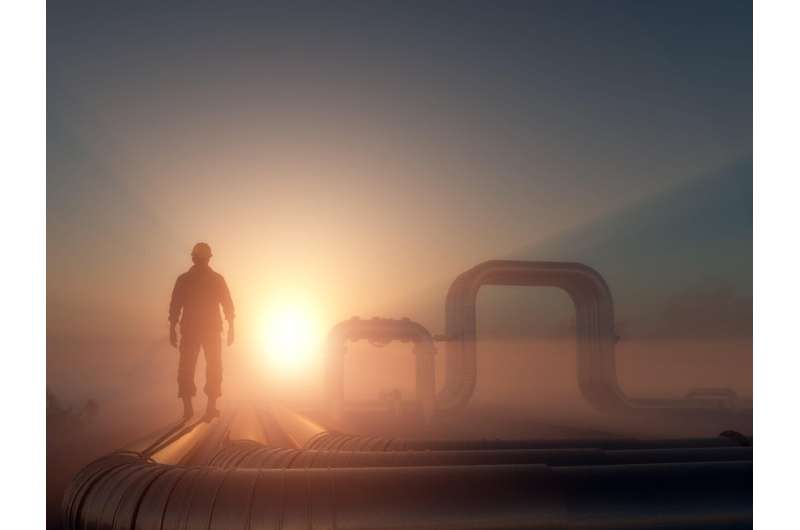This article has been reviewed according to Science X's editorial process and policies. Editors have highlighted the following attributes while ensuring the content's credibility:
fact-checked
reputable news agency
proofread
Outdoor workers face skin cancer danger

Steve Murray, 68, has spent a lot of time out in the sun, at work and at play.
Murray worked construction for several decades, and as a child spent summers on the beach in Ocean City, N.J., and enjoyed winter visits to sunny Florida.
He's also repeatedly battled skin cancer and melanoma, the deadliest form of skin cancer, for decades, starting in the 1990s.
"Back when I was a kid, nobody worried about putting on sunscreen or wearing a hat," Murray, who lives in the Washington, D.C., area, said in a news release. "You just cooked in the sun." The damage is done at an early age, he said, and the price is paid later on.
"I didn't realize the damage I was doing until the late 90s when my dermatologist started seeing things on my skin," Murray added.
Folks like Murray who work outdoors are far more likely to get sunburned and tanned, putting themselves at increased risk for skin cancer, according to a new American Academy of Dermatology survey.
About half of outdoor workers got a sunburn in 2023, compared to 36% reported by Americans overall, the survey found. These include people working in construction, landscaping, emergency medical services and postal delivery, the AAD says.
Further, 1 in 10 outdoor workers received a sunburn severe enough to cause blisters, a rate double that of the general population. And nearly 80% of outdoor workers get a tan or darker skin as a result of sun exposure, compared to 67% of all Americans.
"Since most outdoor workers are exposed to the sun during peak hours of the day, it's vital they adopt sun protection measures as part of their daily routine to safeguard against skin cancer," Dr. Bruce Brod, a clinical professor of dermatology at the University of Pennsylvania in Philadelphia, said in a news release.
Murray was first diagnosed with basal cell carcinoma, the most common type of skin cancer, in the late 1990s. At that time doctors also detected squamous cell carcinoma, a skin cancer that tends to develop in people who've had a lot of sun exposure.
Murray had a bout with melanoma in 2008, and since then, he's been diagnosed with skin cancer several more times. This year alone, he's had two surgeries to remove squamous cell carcinoma from his hand and back.
"I'm in the construction business, and even though I mostly work in the office, I still have to visit the sites and be in the sun," Murray said.
"When you work in the office environment, you don't think about having to go out for an hour, and the fact that in that one hour you cook, and you don't realize it until you get home that night," he continued. "That's when you say to yourself, 'I should have put sunscreen on or I should have worn a hat,' but by that point it's too late."
Murray now visits a dermatologist every three to six months, to keep tabs on his skin health. He also always wears a hat and sunscreen, as well as long sleeves whenever possible.
People who work outside are more likely to protect themselves by wearing a hat—59% compared to 47% of all Americans. Unfortunately, they are also more likely to believe tanning myths.
About 31% of outdoor workers believe the myth that a base tan will prevent sunburns, compared to 23% of Americans overall. And 31% of outdoor workers believe tanning is safe if you don't burn, compared to 20% of Americans.
Brod and the AAD offer sun protection tips that they urge everyone, and especially outdoor workers, to adopt:
- Seek shade, especially when the sun's rays are strongest, between 10 a.m. and 2 p.m.
- Wear sun-protective clothing, including a wide-brimmed hat, a lightweight long-sleeved shirt, pants and sunglasses with UV protection.
- Apply sunscreen SPF30 or higher to all skin not covered by clothing, and reapply every two hours or after swimming or sweating.
People also should consider getting routine skin cancer checks, particularly if they have certain risk factors, Brod said.
"If you have a lot of moles or growths on your skin that you're not sure about, a family history of skin cancer, you've spent a lot of time in the sun, or you've had even one severe sunburn, you owe it to yourself to get your skin checked by a board-certified dermatologist," hesaid.
More information: The Skin Cancer Foundation has more about sun protection.
2024 HealthDay. All rights reserved.





















